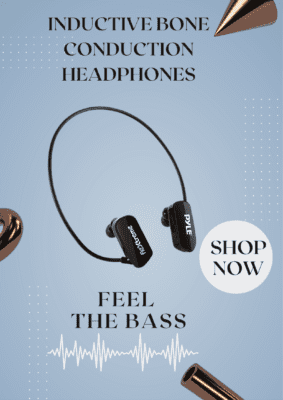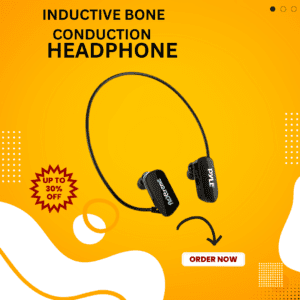
The search for compelling and cutting-edge listening experiences continues. An innovative development that challenges how humans typically hear and absorb audio material is the development of inductive bone conduction headphones.
These bone-conduction headphones expand the possibilities for audiophiles, athletes, and anybody looking for a singular aural experience by fusing the principles of charging. This article explores headphones’ inductive bone conduction technology and its advantages, potential uses, and effects on audio development.
Acquiring Knowledge Of Inductive Bone Conduction Technology
Inductive charging and bone conduction are two different technologies combined in inductive bone conduction headphones. By transmitting sound waves through the bone rather than the eardrum, bone conduction technology enables users to hear audio material without impeding outside sounds.
It sends vibrations to the skull’s bones, which are then communicated to the inner ear and produce the perception of sound. On the other hand, inductive charging is a wireless charging technique that transfers energy between two coils—one in the charging base and the other in the device—using electromagnetic fields.
Application Possibilities
Sports and Fitness: Inductive bone conduction headphones are a sportsperson’s best friend since they let them listen to music or coach instructions without impairing their awareness of their surroundings. Coaches and fitness trainers can use these headphones to provide on-the-go direction.
Medical Devices: The technology has tremendous potential for use in medical applications. It ensures clear audio while maintaining ambient awareness and can be integrated into hearing aids, assistive listening devices, and communication aids for those with hearing impairments.
Inductive bone conduction headphones could improve the immersive experience of virtual reality (VR) and augmented reality (AR) by delivering audio material without isolating users from their environment. This might completely alter how we communicate in virtual environments.
Issues and the Prognosis
While inductive bone conduction headphones provide many benefits, there are still some obstacles. Manufacturers are making a lot of effort to deliver the finest audio quality, manage electromagnetic interference, and ensure device compatibility.
In the future, machine learning and artificial intelligence integration may further improve the individualized listening experience.
Benefits of Inductive Bone Conduction Headphones
Technological developments have changed how we engage with audio in recent years. An extraordinary invention that raises the bar for audio enjoyment is inductive bone conduction headphones.

Unlike traditional headphones, which use speakers to produce sound waves into the ears, these headphones use the principle of bone conduction to transmit sound by vibrations to the inner ear. These innovative methods provide many advantages that adapt to different demands and preferences, making them an exciting development in audio technology.
Situational Awareness Enhanced
Better situational awareness is one of the main benefits of inductive bone conduction headphones. Unlike traditional headphones, bone-conduction wireless headphones expose the ears, which might isolate the user from their environment.
As a result, wearers can listen to music, podcasts, or phone calls while also being alert to outside noises like traffic, people speaking, or alarms. Athletes, cyclists, and those who need to remain alert while connected will find this functionality especially helpful.
Safety and Comfort
Bone conduction wireless headphones‘ comfort level is a game-changer. Traditional headphones can put pressure on the ears or build up heat over prolonged usage, which can be uncomfortable. Inductive bone conduction headphones solve this problem because they don’t need to be inserted into the ear canal.
The bone-conduction wireless headphones are worn gently and wrap comfortably over the cheekbones and temples, sending vibrations straight to the inner ear. They are a safer option for extended use because their design lowers the risk of ear infections and hearing loss.
Advantages of Bone Conduction Inductive Headphones
Open-Ear Listening: Best Inductive bone conduction headphones do not cover or implant into the ears as conventional headphones do.
Comfort and Accessibility: Inductive bone conduction technology can help those who experience discomfort or hearing loss when using conventional headphones.
Safety: By enabling users to hear background noises like traffic or announcements while enjoying their audio content, inductive bone conduction headphones improve user safety. Urban commuters and athletes will benefit from this feature.
Versatility: The technology has uses outside of just entertainment. Health care is one industry that uses the Best Inductive bone conduction headphones because they can be included in communication and hearing aids.
Innovative Design: Headphone models that are svelte, light, and ergonomic can be designed however manufacturers see fit. This promotes blending technology and fashion and appeals to a broad spectrum of customers.
Considerations for Hearing Impairment
For people with specific hearing problems, inductive bone conduction headphones present a possible solution. Bone conduction can directly transmit sound waves to people with conductive hearing loss or single-sided deafness. This bone conduction headphone effectively transports valuable impulses to the inner ear by omitting the outer and middle ear, potentially enhancing the auditory experience for persons with particular hearing issues.
Flexibility when Engaging in Physical Activity
Using standard headphones while exercising can frequently be difficult. Uncomfortably or even dislodgement may result from movement and sweat. However, inductive bone conduction headphones maintain their position during strenuous activity, making them the perfect option for athletes, runners, and gym goers. They can survive the demands of exercise and outdoor activities because of their water-resistant and robust design.
Adventure-Ready Waterproof Design
These Best Inductive bone conduction headphones‘ waterproofing technology was carefully engineered and designed into them. Protecting the delicate electronic components while guaranteeing the best sound quality is one of the main concerns.

Nano-coating and silicone gaskets are two examples of cutting-edge materials and methods that manufacturers use to seal off internal components from moisture incursion.
Inclusivity and Accessibility
Inductive bone conduction headphones are distinguished by their inclusive design. They offer users of hearing aids or cochlear implants an accessible audio option. These users can enjoy sounds from the bone-conduction wireless headphones while still using their assistive devices, improving their overall auditory experience without sacrificing their current aids.
Inductive bone Conduction Headphones last topic benefits
Best Inductive bone conduction headphones represent a fantastic improvement in audio technology. They are a valuable addition to the world of personal audio devices because of their capacity to offer improved situational awareness, comfort, safety, compatibility with hearing impairments, versatility during strenuous activities, and inclusivity.
Bone Conduction Headphones: Exploring Sound Quality and Performance
Constant innovation has resulted in numerous headphones, each serving particular requirements and tastes. Among these, bone conduction headphones have drawn interest for their distinctive method of sound delivery. Bone conduction technology employs vibrations to send sound waves directly through the bones of the skull to the inner ear, in contrast to conventional headphones that rely on air conduction to do so.
Let’s analyze the performance of inductive bone conduction headphones and examine their quality from various angles.
Sound Clarity and Fidelity
When assessing any headphones, one of the main things to look for is how well they reproduce accurate and clear sound. In this regard, inductive bone conduction headphone have advanced significantly.
They can deliver an unusual but straightforward audio experience by bypassing the eardrum and sending vibrations straight to the cochlea. It’s crucial to remember that bone best conduction headphones may not deliver audio quality on par with conventional over-ear or in-ear models, especially in terms of bass response and overall depth. The unusual sound propagation technique may lose the richness and nuance in the audio.
Response from the bass
The bass is a crucial part of music and audio, frequently giving impact and depth to the listening experience. Because of its mechanics, producing loud bass with bone conduction technology can be challenging. The most profound and resonant bass frequencies may not be reproduced to the best of these headphones’ ability, despite manufacturers’ efforts to improve bass response in inductive conducting headphones.
Ambient Noise Isolation
Inductive bone conduction headphones‘ ability to keep users aware of their surroundings while listening to audio is one of their most noticeable features. This situational awareness is beneficial for outdoor activities, workouts, and other circumstances when it can be dangerous to be completely cut off from the outside world.
The overall listening experience, particularly in busy surroundings, may be impacted by this novel design decision’s potential for poor noise isolation and audio leakage.
Comfort and Long-Term Wear
Inductive bone conduction headphones provide a different wearing experience than conventional headphones. They don’t cover or enter the ears, which some users may find more comfortable, especially while using them for a lengthy time.
However, due to variations in skull anatomy and individual preferences, the comfort level might fluctuate significantly from person to person. Finding a pair that fits well and provides high sound quality and comfort is essential.
Five Use Cases
Based on the scenarios for which they are designed to be used, inductive bone headphone quality can be assessed.
A revolutionary method of audio distribution, inductive bone conduction headphones offer a balance between sound quality and situational awareness. They may not be able to compete with high-end traditional headphones in terms of pure audio fidelity. Still, they excel at giving active people a secure and comfortable listening experience.

Inductive bone-conducting headphones will likely get better sound quality and bass response as technology develops, making them an even more alluring alternative for people looking for a combination of audio and awareness. As with all audio equipment, individual preferences and use cases greatly influence the “quality” of these headphones.
Bone Conduction Headphones: Question and Answer
An incredible advancement in personal audio technology is the use of inductive bone-conducting headphones. These headphones avoid the eardrums by transmitting sound directly to the inner ear using the principles of bone conduction.
Due to its intriguing applications, unique characteristics, and possible advantages, this technology has drawn much interest. Through a series of questions and answers, we’ll examine the idea of inductive bone conduction headphones in this article.
Q1: What are inductive conduction headphones?
Best Inductive bone conduction headphones are a particular audio equipment that uses bone conduction technology to transmit sound. This bone conduction headphone eliminates the requirement for customary headphones that rely on air-conducted sound waves by sending good vibrations directly to the skull bone and inner ear instead of using eardrums.
Q2: What is the mechanism behind conduction headphones?
Electromagnetic induction is how these bone-conducting headphones function. They comprise two transducers on the user’s temporal bones, close to their ears. The cochlea in the inner ear is stimulated by these vibrations, which causes the cochlea to vibrate and produce sound.
Q3: What benefits can inductive bone headphones offer?
Benefits of inductive bone best conduction headphones include:
- They enable listeners to remember their surroundings as they listen to audio.
- They can bypass the eardrums, making them very helpful for people with hearing loss.
- They don’t restrict the ear canal, so they are appropriate for outdoor sports like running or cycling.
- They can lower the possibility of ear fatigue and discomfort from conventional headphones.
Q4: Does this technique have any limitations?
Certain restrictions do exist.
- Since bone is the medium for transmitting vibrations, the sound may not be as complete and rich as with conventional headphones.
- Users may encounter audio leakage since those nearby can also feel the vibrations.
- It might be challenging to achieve high volume levels without making people uncomfortable.
- There might be better options for circumstances needing complete noise isolation.
Q5: What possible uses are there for inductive bone headphones?
There are numerous applications for these headphones.
- Situational awareness is crucial for sports and outdoor activities.
- For those using hearing aids or having particular hearing problems, audiobooks and communication are available.
- Examples from the workplace include pilots or security officers who must hear orders while remaining aware of their surroundings.
- Applications in medicine, such as therapy and auditory rehabilitation.
Q6: Is it safe to use inductive conduction headphones?
The prevailing consensus is that inductive bone best conduction headphones are safe. They don’t drive sound waves into the ear canal, which can lessen the chance of permanent hearing loss. However, users should use caution when adjusting the level to avoid discomfort or any potential problems brought on by bone vibration.
Q7: How do these headphones stack up against other bone-conduction technology?
Best Inductive bone conduction headphones use electromagnetic induction to produce vibrations, which sets them apart from other bone conduction devices. They differ from gadgets that rely on mechanical vibrations because of this. The usage of electromagnetic fields could have benefits for audio customization and clarity.
Q8: Is there a notable company or item in this category?
As of my most recent information update in September 2021, the inductive bone conduction headphone market was developing. However, a few brands were producing them. For the most recent details on readily available brands and products, it is advised to check recent reviews and market trends.
Conclusion
Best Inductive bone conduction headphones transform how we listen to audio and offer a safe, comfortable, and immersive auditory experience by integrating cutting-edge technologies.
Their applications are varied and promising, ranging from sports endeavours to medical help and beyond. This bone-conduction headphone can completely change how we interact with sound in different spheres of our lives as technology develops.
A revolutionary method of audio distribution, inductive bone conduction headphones offer a balance between sound quality and situational awareness. They may not be able to compete with high-end traditional bone best conduction headphones in terms of pure audio fidelity. Still, they excel at giving active people a secure and comfortable listening experience.


